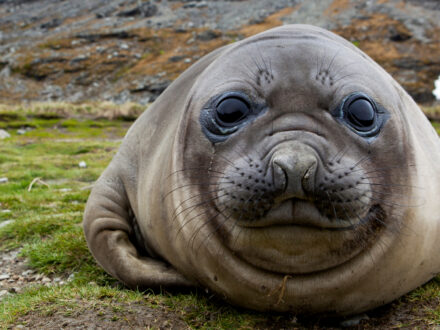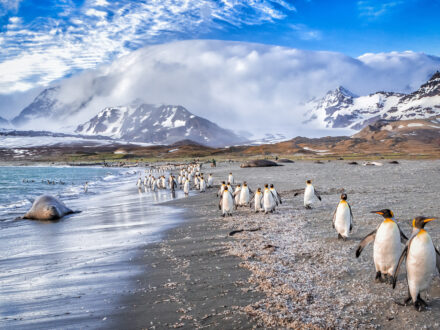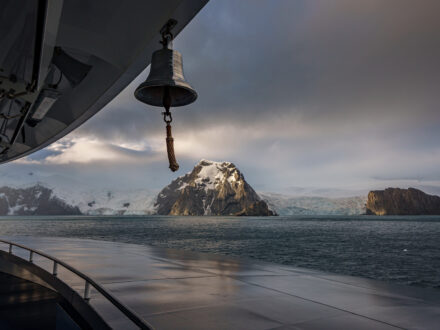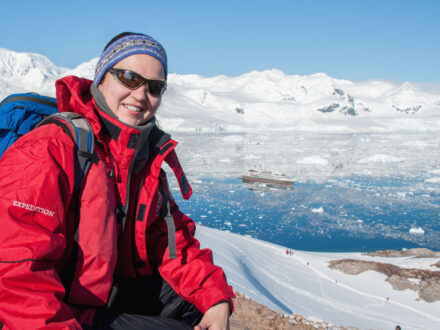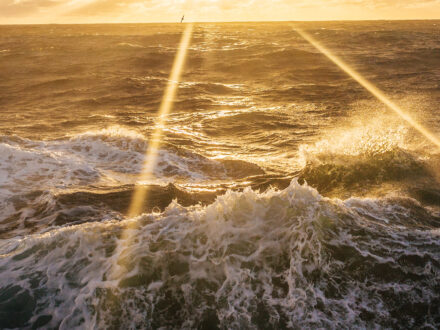Is Antarctica Safe? Dangers To Travelers & How To Avoid Them
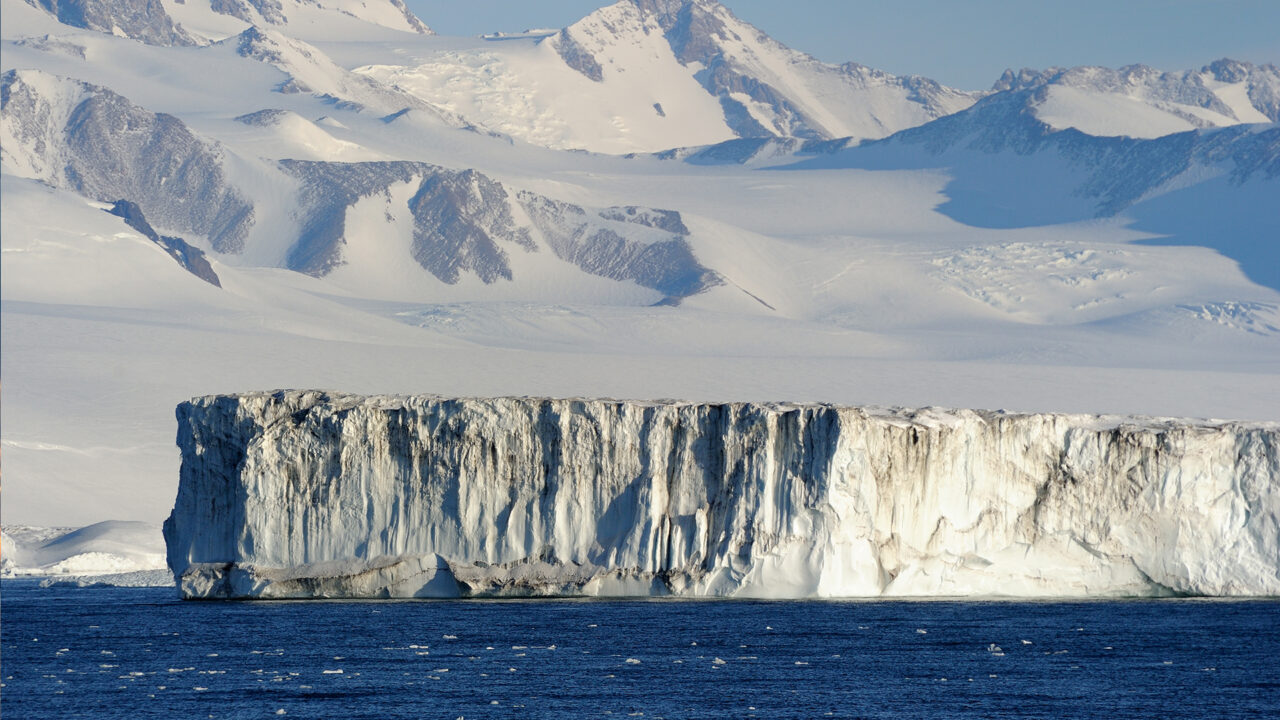
On the surface of things, Antarctica is a pretty forbidding place: the coldest of the continents by far, and also the windiest and driest, and almost—for the average person, anyway—incomprehensibly remote. Vast tracts of crunching sea ice, howling polar winds, months and months of winter darkness: There’s no question this is as environmentally intense as terra firma comes. But—is Antarctica dangerous to visit?
The natural hazards in Antarctica are not, generally speaking, something to fret about as a tourist to the White Continent. You naturally want to pay respect to the rigors and wildness of this vast, untamed realm. But modern-day sightseeing travel here presents minimal risks, giving you a tantalizing taste of—but not risky exposure to—the intense, pristine, all-around awe-inspiring environment.
Cold, Dry, and Windy
It’s cold in Antarctica—obviously! And it’s also windy, particularly along the coastal margins and lowlands, regularly wracked as they are by powerful katabatic winds off the Antarctic ice sheets. Frostbite—the freezing of body tissue and blood vessels—is certainly a risk, as is hypothermia, when one’s body temperature falls to 95 degrees Fahrenheit or lower. If not immediately addressed by warming (and, if need be, drying) a victim, both of these conditions can be very serious: Frostbite may result in the death of body tissue, and hypothermia can be fatal if allowed to progress.
Fortunately, tourists in Antarctica visit on extremely well-supported cruises and expeditions, and, of course, are coming here during the warmest months of the year: the summer season of November through March. And the Antarctic Peninsula that serves as the main destination for most Antarctic cruises is the mildest part of the White Continent.
Zodiac excursions demand proper clothing
Wearing proper clothing—namely, layers of the right material and arrangement, with a moisture-wicking base layer or two overlain by an insulating (often fleece) midlayer and then an outer windproof, waterproof shell, complemented by boots, glove liners and gloves/mittens, and warm headwear—goes a long way toward preventing frostbite and hypothermia. Guides can recognize early signs of frostbite or hypothermia—the initial stages of which are often called the “umbles” in Antarctica, as a hypothermic person begins mumbling, stumbling, and fumbling—and take prompt action to reverse them. And onboard doctors and medical staff are on hand to respond to these sorts of maladies.
Dehydration is also an issue, given the exceptionally dry air prevailing over most of Antarctica. Maintaining a steady intake of fluids is important for visitors and researchers alike. Fingertips have also been known to crack in the dryness. If they won’t heal, superglue works wonders!
Although Antarctica receives surprisingly scanty snowfall—most of the continent is a polar desert—blizzards are certainly a danger, though most summertime visitors on the typical tourist path aren’t going to experience one. Many such whiteouts aren’t produced by heavy falling snow, but rather by those ferocious Antarctic winds whipping up dry powder, resulting in what’s technically called a ground blizzard.
The Polar Glare
The blazing polar sunshine of summer is its own risk on an Antarctic visit, but, again, one readily safeguarded against by the right equipment. Actually, it’s not just the sunlight streaming down from the sky: Much of the problem is the reflected glare off all the snow and ice. Even an overcast day can bring the risk of “snow blindness,” essentially a corneal sunburn.
Wearing proper sunglasses or goggles helps prevent against snow blindness. While you’ll obviously mostly be swaddled up on a trip to Antarctica, sunscreen protects your face and other exposed skin from sunburn and UV radiation. Chapstick is a good idea, too (to protect against dried, cracked lips as well as UV rays).
Weddell Sea penguins on ice
Crevasses
The great glacial cracks known as crevasses, which may be hundreds of feet deep, reflect the mobile, “living” nature of Antarctica’s ice sheets and glaciers. Sometimes clearly visible at the surface, but often masked by snow bridges, crevasses are major hazards to trekkers off the beaten track in the White Continent’s vast icy wilderness. Researchers, climbers, and general-purpose adventurers take precautions against falling into one of these chasms, carefully probing ahead along their route, roping up, and even rigging braces that can catch them should they fall into a hidden crevasse. The creation in 2006 of the McMurdo-South Pole Highway, aka South Pole Traverse—an ice road linking McMurdo Station with the Amundsen-Scott Station—involved filling in crevasses, affording safe passage for vehicles and footbound travelers through such perilous terrain as the Leverett Glacier in the Transantarctic Mountains.
Your average Antarctic tourist, though, isn’t exposed much to crevasses, and any hiking, mountaineering, skiing, and snowshoeing outing will be done on scouted routes and with an experienced certified guide and proper gear.
Altitude
For the most indomitable and intrepid of explorers, the allure of standing at the geographic South Pole is almost impossible to resist, but many are unaware of the lofty heights of Antarctica’s interior and subsequent danger of altitude-related illnesses. To reach the pole, a flight from sea level to the nearby Amundsen-Scott South Pole Station located on the breathtakingly high plateau of Antarctica at 2,835 meters (9,301 feet) above sea level is required. Altitude illness symptoms can occur at elevations anywhere as low as 7,000 feet—indeed in polar regions, hypoxia (inadequate oxygen in the lungs and blood) can even develop at lower altitudes—but the effects of altitude can also be exacerbated by the extreme cold and low barometric pressure prevalent as such high latitudes, so it can actually feel like being at 11,000 feet (3,350 meters) above sea level.
Such an abrupt change in real—let alone perceived—altitude has sometimes lead to high altitude-related illnesses being reported in new arrivals to the station, including Acute Mountain Sickness (AMS) and less commonly High Altitude Pulmonary Edema (HAPE), in some cases resulting in sufferers requiring medical evacuation to McMurdo Station and points north. Famously this exact fate happened to renowned former astronaut Buzz Aldrin, the second person to walk on the moon in 1969, who had to be evacuated from the South Pole in December of 2016 when his medical condition deteriorated. Whilst he was 86 at the time, altitude can affect people of all ages.
Port Lockroy
If you are seeking the extra kudos of visiting the South Pole in Antarctica, to help avoid such complications, where possible a more gradual acclimatization over 3-5 days is advisable, and it is recommended travelers eat a high carbohydrate diet, stay properly hydrated, and avoid overexertion and any depressant drugs like alcohol, nicotine or sleeping pills. Some recommend taking three or four aspirin on the flight to the Pole to ease the headache commonly experienced with altitude, while others find ginkgo or Diamox (acetazolamide) helpful. The extra elevation also elevates our blood pressure, sometimes to such an extent that it exceeds the outside air pressure causing our blood vessels to rupture. To help prevent nosebleeds, travelers often pack their nostrils with vaseline.
Antarctica Dangers to Ship Travel: The Drake Passage, Ice, Rough Seas
Maritime travel to Antarctica contends with some inherently gnarly conditions, namely the rough seas of the Southern Ocean and the extensive sea ice of the polar realm. The Drake Passage, which separates Tierra del Fuego from the South Shetland Islands off the Antarctic Peninsula, has a notorious reputation for unruly swells and strong winds—a function of it being the narrowest chokepoint of the Southern Ocean, concentrating the powerful westerlies and surging Antarctic Circumpolar Current.
But many traverses of the Drake are remarkably placid—the oft-experienced “Drake Lake” calm—and, furthermore, Antarctic cruising vessels are mighty sturdy and capable of steering around (or, if need be, stalling in the face of) the worst storms. As we’ve explained in another post, Drake Passage crossings aren’t dangerous for cruise passengers, who at worst typically just experience seasickness. Every so often, accidents do happen—in 2010, for example, a cruise ship was damaged by a big Drake wave, though no passengers were injured, and in 2022 a rogue wave tragically resulted in a passenger fatality. But such events are rare indeed.
Calm midnight waters in Drake Passage
Icebergs and ice floes are definitely a challenge for ships navigating Antarctic waters—with multi-year sea ice the thickest, hardest, and most obstructive—but today’s touring vessels are well-equipped to meet it. The most robust ships operating in Antarctica are heavy-duty icebreakers, often used for research and transport. Most cruises, though, take place via ice-strengthened vessels, which ride more comfortably in open water than their icebreaker counterparts. Ice-strengthened (or ice-hardened) ships possess multiple special features for negotiating Antarctic ice, including a reinforced, flat, double hull clear of protrusions that allows them to nose through—or override and break through—floes and bergs. You’ll often see Antarctic cruise and expedition crafts rated by the Finnish ice-class system, ranging down in ice-hardiness from 1A to 1B to 1C (and so forth).
Maritime accidents these days are pretty uncommon in Antarctica. Ice, rough seas, and storms periodically cause fishing vessels and other smaller craft to founder or run aground. Significant incidents involving cruise ships, including expedition craft, are few and far between. The first cruise ship to sink in Antarctic waters was the MV Explorer, a Liberian-registered vessel damaged in November 2007 by ice in the vicinity of the South Shetland Islands, and—after all passengers and crew members were rescued—sank in the Bransfield Strait. That accident was an unusual one, with human error apparently playing an important role, and resulted in new safety regulations for Antarctic cruising.
In December 2013, the Russian ship Akademik Shokalskiy—ferrying 52 passengers, both scientists and tourists, on a research and sightseeing trip tracing the 1911-1913 route of Sir Douglas Mawson’s expedition—became icebound near Cape de la Motte. All passengers were evacuated by helicopter to an Australian icebreaker, while the crew stayed behind on the well-stocked ship to await the breakup of the ice.
Shipboard Safety
As unlikely as abandoning ship or an evacuation may be—due to tempestuous conditions, icy hazards, or otherwise—practicing for such an eventuality is imperative. International law requires every ship to hold a lifeboat drill within 24 hours of sailing. Upon the universal signal of seven short blasts on the ship’s bell or horn, all passengers must immediately head to their cabin to don warm clothes and their life vest before proceeding swiftly to a designated lifeboat station.
More likely are accidents—specifically falls—arising from stormy seas and inclement weather, with the subsequent slippery decks making conditions difficult for those unsure of foot. A fall overboard is often fatal, so always keep one hand free (‘for the ship’) to grab a railing should the ship roll suddenly. Take extra care when scaling ladders or stairs, and avoid curling your fingers around door jambs as doors can sometimes swing shut dangerously.
Antarctica ice bergs
Wildlife
There are, to be clear, some formidable critters down in Antarctica. We’re talking gigantic southern elephant seals, the bulls of which—brawling it out to earn “beachmaster” rights—can reach 20 feet and multiple tons. Then there are the leopard seals: big, fierce predators fond of penguin and seal flesh. And that’s not even getting to the orcas, or killer whales.
Yet the risk posed by these magnificent animals to your average Antarctic tourist is minimal. As long as you give them plenty of space—a mandate to follow when it comes to any Antarctic wildlife, dangerous or not, with strict guidelines laid out by the International Association of Antarctic Tour Operators—you’re exceedingly unlikely to run into trouble with polar predators.
Scuba divers—a small subset of Antarctic tourists—should certainly be cognizant of the potential threat posed by the leopard seal, despite the fact this toothy pinniped is very unlikely to tangle with humans. It has been implicated in a few aggressive incidents toward people: most tragically, an unprecedented fatal 2003 attack on a British marine biologist snorkeling off the Antarctic Peninsula.
How Dangerous is Antarctica?
When one considers the scale of Antarctica’s wilderness and the singular harshness of its environment, it’s especially remarkable to reflect on how safe White Continent tourism is.
A crew of scientists striking out from a research base to do fieldwork must be well prepared to deal with life-threatening emergencies in the world’s greatest and fiercest backcountry. The same goes, naturally, for those adventurers and endurance athletes testing themselves on continental crossings and other extreme feats.
But sightseers touring Antarctica on a cruise, even engaging in such wonderful off-ship adventures as kayaking, skiing, and camping, have a robust security net around them at all times, backed up by expert crews, medical care, essential gear, and contingency plans. This makes the otherwise fearsome White Continent overall a very safe—and utterly life-changing—travel destination.
Disclaimer
Our travel guides are for informational purposes only. While we aim to provide accurate and up-to-date information, Antarctica Cruises makes no representations as to the accuracy or completeness of any information in our guides or found by following any link on this site.
Antarctica Cruises cannot and will not accept responsibility for any omissions or inaccuracies, or for any consequences arising therefrom, including any losses, injuries, or damages resulting from the display or use of this information.










































